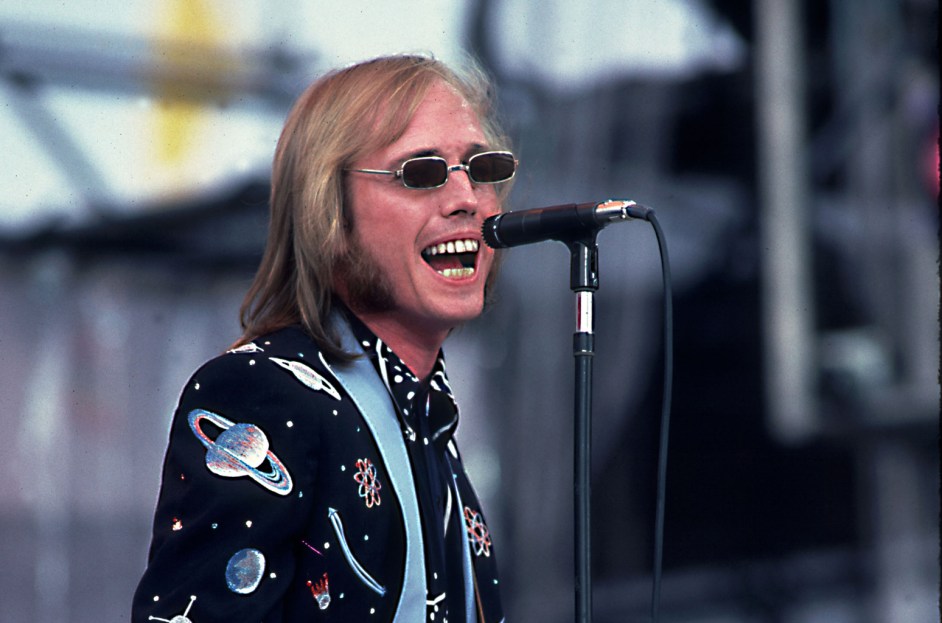
Tom Petty at Live Aid on July 13, 1985 in Philadelphia.
Paul Natkin/WireImage
The headlines and highlights of Live Aid have become legendary during the past 40 years.
Queen blew the roof off at Wembley Stadium in London — or would have if there was a roof. Lone Stone Mick Jagger rolled on his own and with Tina Turner at JFK Stadium in Philadelphia (and made that spirited “Dancing in the Street” video with David Bowie). A post-controversy Madonna declared that she “ain’t taking s–t off” at JFK. Phil Collins jetted trans-Atlantic to play on both sides of the pond, on his own and with Led Zeppelin and Eric Clapton. Sets by Bowie, U2, a reunited Who and Patti LaBelle, the return of Teddy Pendergrass to the stage for the first time since being paralyzed in a car crash three year’s prior and Paul McCartney’s London-closing “Let It Be,” his first live performance in six years, are still being talked about four decades later.
And the laid eggs by Led Zeppelin, also reunited, and Bob Dylan (with Rolling Stones Keith Richards and Ronnie Wood) have achieved their own infamous stature. But keep in mind there were 57 acts between those two venues — and that’s not counting other concerts from Europe, Australia, Japan and the Soviet Union that were also part of the worldwide telethon. It’s inevitable, then, that quite a few of the day’s stellar sets fell by the proverbial wayside.
So with the world celebrating Live Aid 40 on Sunday (July 130 — including replays on the BBC and 80sCentral.com and the premiere of CNN’s four-week documentary Live Aid: When Rock ‘n’ Roll Took on the World — we wanted to dig in and steer folks to the dozen performances, that deserve greater attention and appreciation…
-
Bryan Ferry
Organizer Bob Geldof recalls that the Roxy Music frontman was “the only one who moaned” after the Live Aid lineup was first announced; “Bryan called me up and said, “I never agreed to do this’ and I said, ‘Well, I thought you had.’ And he said, ‘OK, I’ll let you know,’ and I said, ‘Well, I announced you Bryan, so that’s it.’” Ferry certainly lived up to the challenge; with Pink Floyd’s David Gilmour in his band he presented a smooth and sophisticated exposition that pulled three tracks from his then-new solo album Boys and Girls — “Slave to Love,” “Sensation” and the title track — as well as his cover of “Jealous Guy,” giving the late John Lennon a deserved presence in the proceedings.
-
Ultravox
Next to Geldof, Midge Ure was perhaps Live Aid’s most significant musical stakeholder in the cause, having co-written and co-produced “Do They Know It’s Christmas?” and serving on the board of the Band Aid Trust. Like Geldof with the Boomtown Rats, Ure was able to step back into his “day job” and lead Ultravox through a powerful, anthemic four-song set whose “Dancing With Tears in My Eyes,” though released more than six months before Band Aid’s launch, took on profound new resonance in the context of the show.
-
Crosby, Stills, Nash & Young
This reunion by the superstar act, which had been largely apart since its 1974 tour, should have been a bigger deal than it was. But its low-key two-song set (“Only Love Can Break Your Heart” and “Daylight Again/Find the Cost of Freedom”) suffered, perhaps, by being sandwiched between Led Zeppelin and Duran Duran. “We were nervous, a little, only because we hadn’t played together for awhile,” says Graham Nash, who’d performed early with David Crosby and Stephen Stills, while Young also did his own set. “But we did pretty good.”
-
The Four Tops
Don’t forget the Motor City; not counting Ashford & Simpson — who’d changed labels by then — the Tops gave Motown a seat the Live Aid table. Coming on early, the quartet did indeed shake and wake a youthful JFK crowd that seemed to recognize the song caliber in a non-stop 12-minute medley of “Shake Me, Wake Me (When It’s Over),” “Bernadette,” “It’s the Same Old Song,” “Reach Out I’ll Be There” and “I Can’t Help Myself (Sugar Pie, Honey Bunch).”
-
Sade
The British group, which had declined to be part of “Do They Know It’s Christmas?,” was still riding high on its four-times platinum Diamond Life debut and preparing for the upcoming Promise (which would debut at No. 1 on the Billboard 200 after its November release) when it played Live Aid London as one of a half-dozen summer shows. Its three-song afternoon set, which included the hit “Your Love Is King” but eschewing “Smooth Operator,” was smooth and succinct — perhaps, like these others, lost amidst the high points to come, but still well worth a revisit.
-
Run-D.M.C.
The Hollis trio, just two albums into its recording career, served as rap’s ambassador at Live Aid. With its movie premiere, Krush Groove, three months away, the group didn’t get much time but certainly made JFK fans want more with a pairing of “Jam Master Jay” and “King of Rock,” throwing down an intentional gauntlet that both the group and its genre were to be reckoned with.
-
Elton John
Another one of the day’s biggest names who was subsumed by circumstance — namely, coming after Queen and Bowie had their way, and with anticipation for McCartney building. The Rocket Man’s portion of the show held its own, however, with some of his biggest hits (“I’m Still Standing,” “Bennie and the Jets” and “Rocket Man”) as well as Kiki Dee joining him for their duet “Don’t Go Breaking My Heart” and Wham! coming on for “Don’t Let the Sun Go Down on Me.”
-
Pretenders
After a busy 1984 promoting its platinum Learning to Crawl album, Chrissie Hynde and company were taking 1985 off the road to work on new music. Live Aid in Philadelphia was one of just three performances that year, following warm-up shows in Urbana, Ill. and, the night before Live Aid, at the Philly’s Chestnut Cabaret. It clearly didn’t take the troupe long to get up to ramming speed, and it tore through a five-song set that also marked one of the last hurrahs for the rhythm section of Martin Chambers and Malcolm Foster.
-
Black Sabbath
Amidst the high-profile reunions of Led Zeppelin and the Who, the first performance by the original lineup of this heavy metal standard-bearer in six years — since Ozzy Osbourne’s acrimonious departure — has gotten short-shrift. But the triplet of “Children of the Grave,” “Iron Man” and “Paranoid” was as hot as the weather in Philadelphia. “We weren’t exactly on good terms with each other,” bassist Geezer Butler remembers, “but we said yes because it was a good cause, and because we wanted to represent metal. Unfortunately, we were given the unearthly slot of (9:55 a.m.), and a couple of us had hangovers after overdoing it the night before. I think it went OK.”
The bonhomie was short-lived, however; Osbourne and his wife/manager Sharon Osbourne were served papers for a lawsuit filed by her father, Sabbath manager Don Arden, accusing them of trying to lure the band away from him. The suit was eventually dropped after Sabbath parted ways with Arden.
-
Dire Straits
One of the top bands in the world that summer, the Straits was in the midst of a 12-date run at nearby Wembley Arena — and, in fact, had a show there that night, while Live Aid was going on. The group trooped over after its sound check at the arena, played “Money for Nothing” (with Sting recreating his part on the record) and “Sultans of Swing,” then went back, having done its bit — very well — but eclipsed by the Queen and Bowie performances that immediately followed.
-
Tom Petty and the Heartbreakers
Some of the strongest Live Aid sets came from acts that were actively touring at the time (Bryan Adams, the Cars, Santana, Eric Clapton (who canceled shows to play in Philadelphia), Rick Springfield, Hall & Oates, etc.). Petty and company, supporting their new Southern Accents album, came out primed and fit, delivering a four-song career microcosm — “American Girl,” “The Waiting,” “Rebels” and “Refugee.” Guitarist Mike Campbell recalls that, “When there’s that many people (on the bill) it’s just a wash; they’re out there and you’re out there doing your thing. It’s all grand gestures in a big gig like that. But I felt very honored to be part of it, and I thought we played pretty well. And we were feeding the world — what’s wrong with that?”
-
George Thorogood and the Destroyers
By his telling, Thorogood and his band were called on late the night before Live Aid to fly from San Francisco to Philadelphia and fill in for last-minute cancelation (reportedly Tears for Fears). “So we had to immediately jump on an airplane and get over there and do that, ’cause…people were hungry,” Thorogood says now. In addition to showing up, Thorogood also flew in Bo Diddley to play on a rendition of “Who Do You Love?” and Albert Collins” for “Madison Blues,” hot jams that, in addition to Elmore James’ “The Sky is Crying,” fueled one of the most musically ferocious performances in any of the venues. “It went so fast and I was so tired — remember, we didn’t have any sleep at all — and it was brutally hot,” remembers Thorogood, who says he’s never watched footage of his set. “It must have been a success, ’cause they didn’t throw anything at us.”

